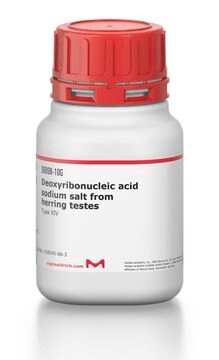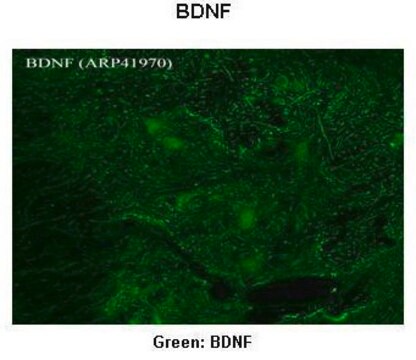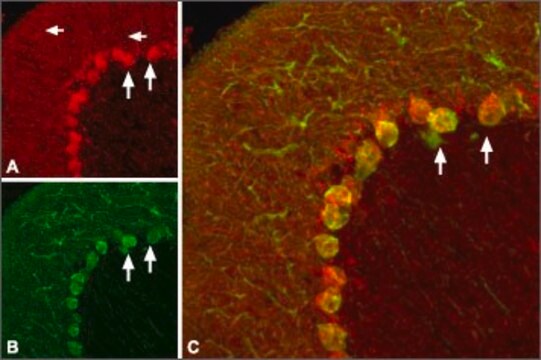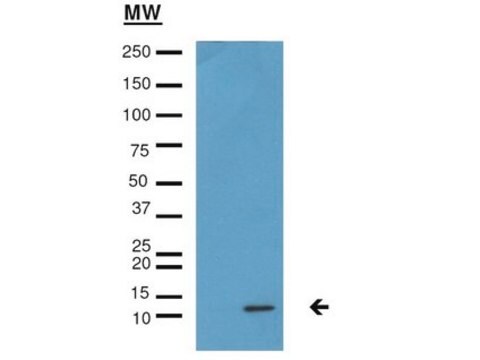05-690
Anti-HP1γ Antibody, clone 42s2
clone 42s2, Upstate®, from mouse
동의어(들):
HP1 gamma, HP1 gamma homolog, Heterochromatin protein 1 homolog gamma, Modifier 2 protein, chromobox homolog 3, chromobox homolog 3 (Drosophila HP1 gamma), chromobox homolog 3 (HP1 gamma homolog, Drosophila), heterochromatin protein HP1 gamma, heterochro
로그인조직 및 계약 가격 보기
모든 사진(1)
About This Item
UNSPSC 코드:
12352203
eCl@ss:
32160702
NACRES:
NA.41
추천 제품
생물학적 소스
mouse
Quality Level
항체 형태
purified antibody
항체 생산 유형
primary antibodies
클론
42s2, monoclonal
종 반응성
human, mouse
제조업체/상표
Upstate®
기술
ChIP: suitable
immunohistochemistry: suitable
western blot: suitable
동형
IgG1
NCBI 수납 번호
UniProt 수납 번호
배송 상태
dry ice
타겟 번역 후 변형
unmodified
유전자 정보
human ... CBX3(11335)
일반 설명
Chromatin assembly factor-1 (CAF-1) is a multisubunit protein complex that comprises three polypeptide subunits known as p150, p60, and p48. CAF-1 is a nucleosome assembly factor that deposits newly synthesized and acetylated histones H3/H4 into nascent chromatin during DNA replication. The p150 subunit of CAF-1 also supports the maintenance of heterochromatin, which requires the synthesis of both new histones and heterochromatin proteins and their orderly assembly during DNA replication.
Heterochromatin is characterized as densely coiled chromatin that generally replicates late during S phase, has a low gene density, and contains large blocks of repetitive DNA that is relatively inaccessible to DNA-modifying reagents. In late S phase, p150 directly associates with heterochromatin associated proteins 1 (HP1α, HP1β and HP1γ). As cells prepare for mitosis, CAF-1 p150 and some HP1 progressively dissociate from heterochromatin, coinciding with the phosphorylation of histone H3. The HP1 proteins reassociate with chromatin at the end of mitosis, as histone H3 is dephosphorylated
Heterochromatin is characterized as densely coiled chromatin that generally replicates late during S phase, has a low gene density, and contains large blocks of repetitive DNA that is relatively inaccessible to DNA-modifying reagents. In late S phase, p150 directly associates with heterochromatin associated proteins 1 (HP1α, HP1β and HP1γ). As cells prepare for mitosis, CAF-1 p150 and some HP1 progressively dissociate from heterochromatin, coinciding with the phosphorylation of histone H3. The HP1 proteins reassociate with chromatin at the end of mitosis, as histone H3 is dephosphorylated
특이성
Reactivity with other species has not been determined.
This antibody recognizes HP1γ protein, Mr ~25 kDa.
면역원
GST fusion protein corresponding to residues 17-173 of human HP1γ protein. Clone 42s2.
애플리케이션
Immunohistochemistry:
This antibody has been reported by an independent laboratory to detect HP1γ positive cells in breast tissue.
Immunoprecipitation/Chromatin Immunoprecipitation:
This antibody has been reported by an independent laboratory to immunoprecipitate HP1γ from nuclear extracts and formalin-cross-linked chromatin.
This antibody has been reported by an independent laboratory to detect HP1γ positive cells in breast tissue.
Immunoprecipitation/Chromatin Immunoprecipitation:
This antibody has been reported by an independent laboratory to immunoprecipitate HP1γ from nuclear extracts and formalin-cross-linked chromatin.
Research Category
Epigenetics & Nuclear Function
Epigenetics & Nuclear Function
Research Sub Category
Chromatin Biology
Chromatin Biology
Use Anti-HP1γ Antibody, clone 42s2 (Mouse Monoclonal Antibody) validated in ChIP, IHC, WB to detect HP1γ also known as Heterochromatin protein 1 homolog gamma.
품질
Routinely evaluated by western blot in acid-extracted HeLa cell lysates (Catalog #13-112).
Western Blot Analysis:
0.01-0.1 µg/mL of this lot detected HP1γ protein in acid-extracted HeLa cell lysates (Catalog # 13-112).
Western Blot Analysis:
0.01-0.1 µg/mL of this lot detected HP1γ protein in acid-extracted HeLa cell lysates (Catalog # 13-112).
표적 설명
25 kDa
물리적 형태
Format: Purified
Protein G Purified
Purified mouse monoclonal IgG1 in buffer containing 0.014 M phosphate buffer, pH 7.6, 0.175M NaCl, 0.07% sodium azide, and 30% glycerol. Liquid at -20ºC.
저장 및 안정성
Stable for 1 year at -20°C from date of receipt. For maximum recovery of product, centrifuge the vial prior to removing the cap.
분석 메모
Control
HeLa acid extracts, HEK 293 nuclear extracts.
HeLa acid extracts, HEK 293 nuclear extracts.
기타 정보
Concentration: Please refer to the Certificate of Analysis for the lot-specific concentration.
Due to license agreement restrictions, this product cannot be purchased for resale.
법적 정보
UPSTATE is a registered trademark of Merck KGaA, Darmstadt, Germany
면책조항
Unless otherwise stated in our catalog or other company documentation accompanying the product(s), our products are intended for research use only and are not to be used for any other purpose, which includes but is not limited to, unauthorized commercial uses, in vitro diagnostic uses, ex vivo or in vivo therapeutic uses or any type of consumption or application to humans or animals.
적합한 제품을 찾을 수 없으신가요?
당사의 제품 선택기 도구.을(를) 시도해 보세요.
Storage Class Code
10 - Combustible liquids
WGK
WGK 1
시험 성적서(COA)
제품의 로트/배치 번호를 입력하여 시험 성적서(COA)을 검색하십시오. 로트 및 배치 번호는 제품 라벨에 있는 ‘로트’ 또는 ‘배치’라는 용어 뒤에서 찾을 수 있습니다.
A NF-?B-dependent dual promoter-enhancer initiates the lipopolysaccharide-mediated transcriptional activation of the chicken lysozyme in macrophages.
Witham, J; Ouboussad, L; Lefevre, PF
Testing null
Epigenetic modulation of gene expression from quiescent herpes simplex virus genomes.
Michael W Ferenczy,Neal A DeLuca
Journal of virology null
Rosa M Marion et al.
Cell stem cell, 4(2), 141-154 (2009-02-10)
Telomere shortening is associated with organismal aging. iPS cells have been recently derived from old patients; however, it is not known whether telomere chromatin acquires the same characteristics as in ES cells. We show here that telomeres are elongated in
Eva Bártová et al.
Differentiation; research in biological diversity, 76(1), 24-32 (2007-06-19)
Human embryonic stem cells (hES) are unique in their pluripotency and capacity for self-renewal. Therefore, we have studied the differences in the level of chromatin condensation in pluripotent and all-trans retinoic acid-differentiated hES cells. Nuclear patterns of the Oct4 (6p21.33)
Jonathan A Ewald et al.
The Prostate, 73(4), 337-345 (2012-08-23)
The treatment of non-localized prostate cancer involves androgen deprivation (AD) therapy which results in tumor regression. Apoptosis has been implicated in the tumor response to AD, but constitutes a small fraction of the total tumor at any time. Cellular senescence
자사의 과학자팀은 생명 과학, 재료 과학, 화학 합성, 크로마토그래피, 분석 및 기타 많은 영역을 포함한 모든 과학 분야에 경험이 있습니다..
고객지원팀으로 연락바랍니다.








